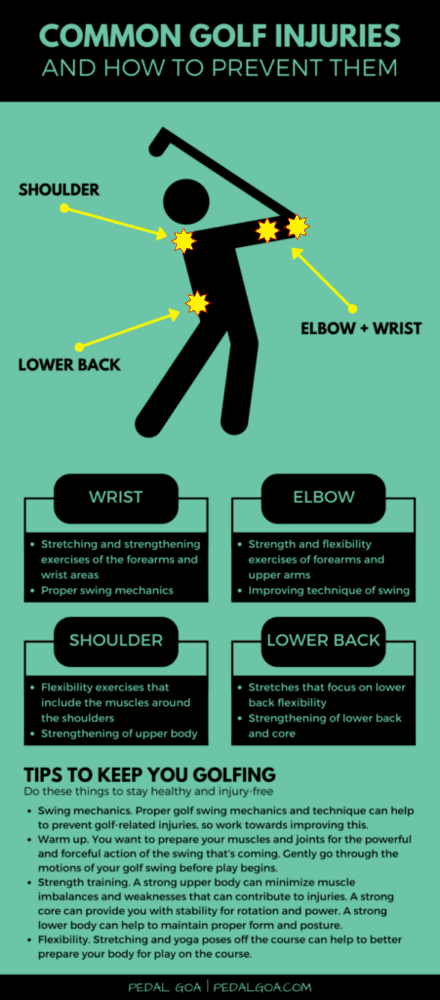The best golfer workout routine makes you exercise your wrists, elbows, shoulders, torso, hips, and knees as those are essential for a strong powerful swing. Ideal workouts include Hinges, Neck & shoulder stretches and hip and trunk rotational exercises.
Today it is more common than ever to see golfers working out and embarking on rigorous strength training programs.
This trend is because golf is no longer seen as a sport limited to precision, accuracy, and mental willpower. More and more golf is becoming a power activity, as courses become longer and player hit farther.
These changes have increased the status of golf in the public eye, solidifying its placement as a world class sport.
However, it can be harder for new or amateur players to identify what exercises are needed to keep up in an increasingly competitive golf world.
Reasons For Golfers to Workout
Golf workouts today revolve around two necessities: the need to maintain a level of fitness that will reduce the likelihood of injuries and to reach the strength and flexibility required for a more efficient game.
The first point is just as important in your workout and should never be overlooked in favor of flashier strength training.
Injury Stats
Amateur golfers incur injuries different from professionals, using indicating a flaw in their gameplay or stance. Among professional golfers, roughly 80 percent of injuries are the result of overuse.
The wrists, shoulders, back, and hips are the most common areas of injuries in pro players. Lower back and shoulder injuries are also common for amateur players, in addition to elbow injuries.
Among amateurs injury often occurs from unhealthy swing patterns. Players fail to take into account their physical limitations and develop swing habits that their muscles cannot sustain.
Often injuries are the result of overstressing the body and worsening pre-existing conditions.
Essential Skills and Muscle for Golf
When you think about what kind of workout you need, it’s important to do an assessment of your intended physical activity or sport.
We can consider this in terms of two areas: biomechanical or physiological.
Biomechanical refers to the muscles and joints you will use and how they will be used. In the golf swing, wrists, elbows, shoulders, torso, hips, and knees are all used. Grip strength, leg-hip strength, and trunk power were all found to be important areas to train to improve performance.
Physiological components consider aspects that affect the body internally, like the duration of activity, rest time, and amount of force needed in the action. The golf swing requires strong, sudden force, and has long rest periods between each swing. The swing itself is very brief.
We can see that an effective golf training program should strengthen the areas of the body listed above. To simulate the physiological aspects of a game, this workout should also have short, explosive exercises that imitate the muscle use and movement of the golf swing.
Start Your Workout!
We’ll cover screening, warm-ups, posture exercises, rotation exercises, and finally, strength training.
Screening and Assessment
Before you begin any training program, it’s ideal to get screened.
One of the biggest limitations of a self-directed workout program is the absence of an initial assessment and a correctional period to first address any dysfunctions.
Certified trainer Ryan Blackburn maintains that all basic human movements should be possible without strain or significant differences between the right and left sides of the body, or asymmetries.
Assessment is important in identifying any asymmetries and correcting them before a workout regimen, which can aggravate any pre-existing conditions if not addressed.
The Titleist Performance Institute (TPI) or Functional Movement Screen (FMS) are both excellent resources for an assessment. Even though getting screened by a certified professional is preferable, there are ways to do a self-assessment.
There are screening assessments for all areas of the body, so doing it on your own can be tedious. Many guides available focus on one part of the body at a time, like this in-depth assessment on ankles.
For multiple assessments in one place, you can check out TPI’s series of free video screening guides.
Other guides provided by trainers compile a series of exercises into a simpler test that can be completed more quickly.
These will not be as in-depth as an assessment of a certified professional, however, they can provide a good starting point and allow you to get started more quickly.
Warm-up!
As with any workout, it’s important to warm-up. If you have a usual routine you like to follow that will do, but we’ll give you a few more ideas.
Always begin with basic stretches to prepare your muscles and reduce the risk of injury during a workout.
Aim to do some stretches in every major muscle group. You should be stretching your arms, legs, trunk, and back.
Most people are familiar with static stretches, which involve holding a position or stretch for usually 10 to 30 seconds at a time. Another type is dynamic stretching, in which you continue to move your body in a full range of motion.
Golf-specific stretches
Golf requires a lot of rotation, and many stretches intended specifically for golfers reflect that. These are a combination of static and dynamic stretches to try.
Neck stretch
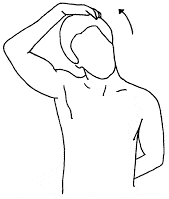
Slowly lean your head to the right, pulling your right ear towards your right shoulder.
You should feel the muscles on the left side of your next stretch. Repeat for the other side, pulling your left ear towards your left shoulder.
Shoulder stretch
Hold a towel in your right hand. Lift your right arm above your head, then bring the right palm behind your back, keeping your elbow in the air.
Gently pull down on the towel with your left hand, holding for a few seconds. Repeat with your left arm. Do five repetitions of each.
Here’s a cool video showing both neck and shoulder stretch:
Bending shoulder stretch
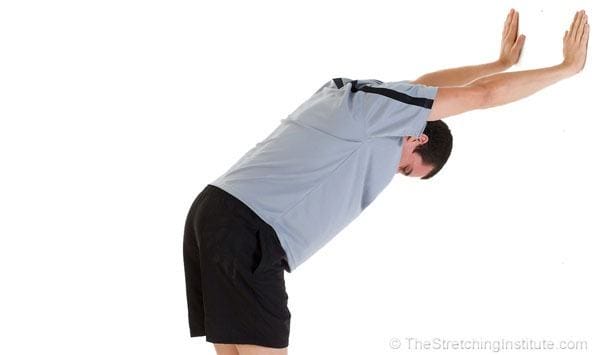
Hold a club resting on the ground or place your hands on a wall in front of you.
Bend at the waist until your upper body and straight arms are parallel with the ground, with your back flat.
You should feel a stretch in your shoulders. Hold for ten seconds, rest and then repeat for five repetitions.
Controlled Articular Rotations for the shoulders
With your right arm straight out in front of you, move it backward slowly to form a complete circle, keeping your arm straight the entire time.
Imagine your arm is moving against a wall, or perform the stretch against an actual wall to keep your arm moving straight up and down instead of straying outwards.
Repeat for your left arm and in the opposite direction for five repetitions each.
Arm swings
Standing upright, swing your arms back and forth across the front of your body. Continue without stopping for 30 seconds.
Wrist extensions
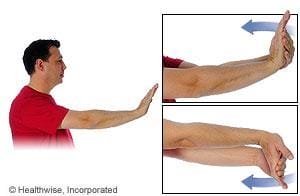
Hold your right arm out straight in front of you.
Use your left hand to gently pull back the fingers of your right hand until you feel the stretch in your forearm.
Hold for ten seconds then repeat on your left.
Standing upper back stretch
For this stretch, you can use your club, or a towel. Hold a club or towel in front of you at shoulder height.
Keep your knees bent and your posture upright. Inhale as you push your arms out, exhale as you pull your arms in and your elbows back, gently squeezing your shoulder blades together.
Trunk rotation
While standing, bring your palms together in front. Twist your core to the right, reaching out with your right arm, but not completely straightening it. Inhale as you do so.
Return to original position and exhale when your palms meet, or clap.
Do the same for your left side. Complete this for each side ten times.
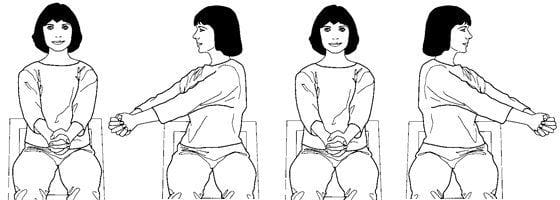
Side bends with club
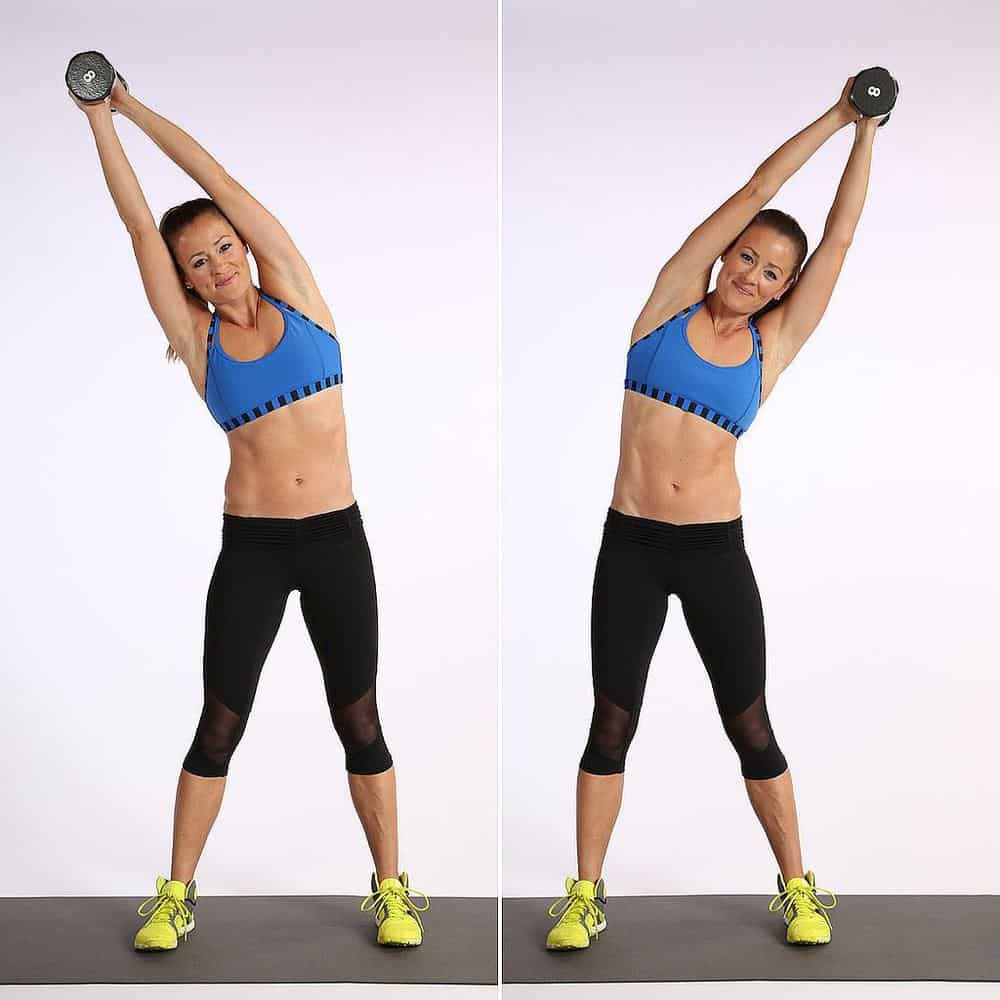
Place a club on your shoulders and hold each end. Keep your knees slightly bent, and lean to the right, using the club to help keep your trunk straight.
Hold briefly before leaning to the other side. Do ten repetitions for each side.
Standing pelvic tilts

Begin standing with arms crossed across your chest. Lean your pelvis back creating a curve, but keep your upper body upright.
Next push the pelvis forward while arching your back, again keeping your upper body relatively straight. Repeat five times in each direction.
Controlled Articular Rotations for the hip
Start off on your hands and knees. Raise your right leg, keeping your knee at a 90-degree angle and slowly move your knee back, and around in a circle.
At the top of the circle, your thigh should be parallel to your back. Bring your knee back down, almost not quite touching the ground and continue in another circle.
Repeat five repetitions on each side. Reverse the direction of your circles and complete another five repetitions.
Here’s a video example.
Leg swings
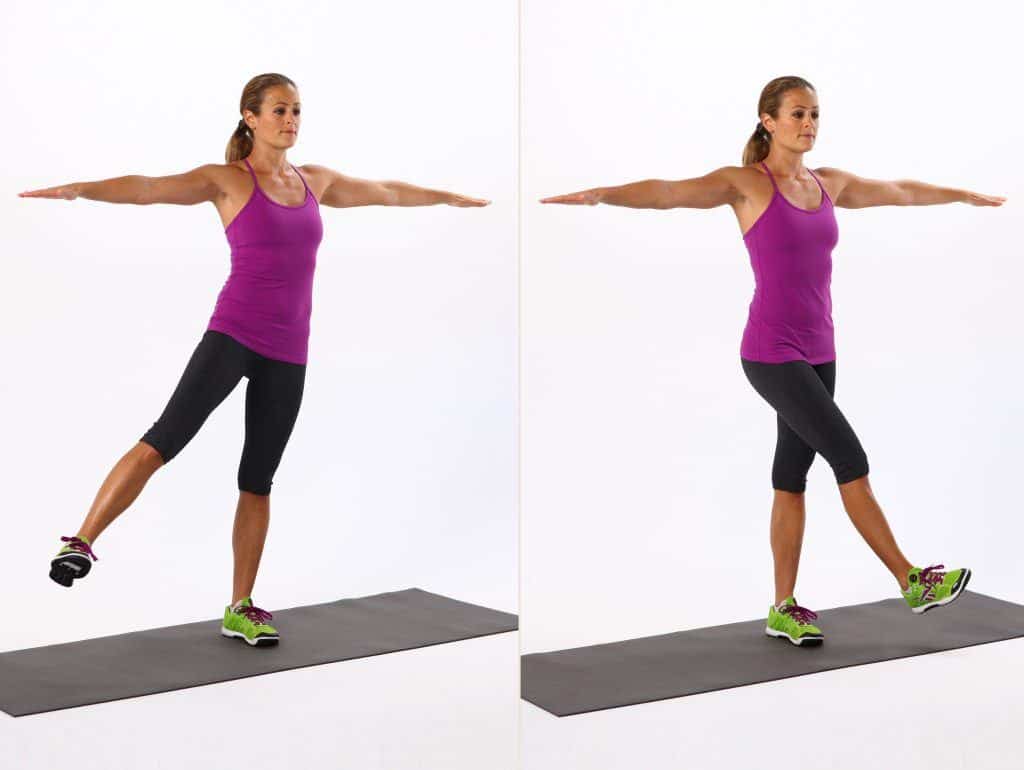
Stand with your feet shoulder-width apart. Keep your torso upright and swing your right leg back and forth as far as your natural range of movement.
Be careful not to swing so hard that you cannot stay upright. Repeat for ten front to back swings on each leg.
Alternate toe touches
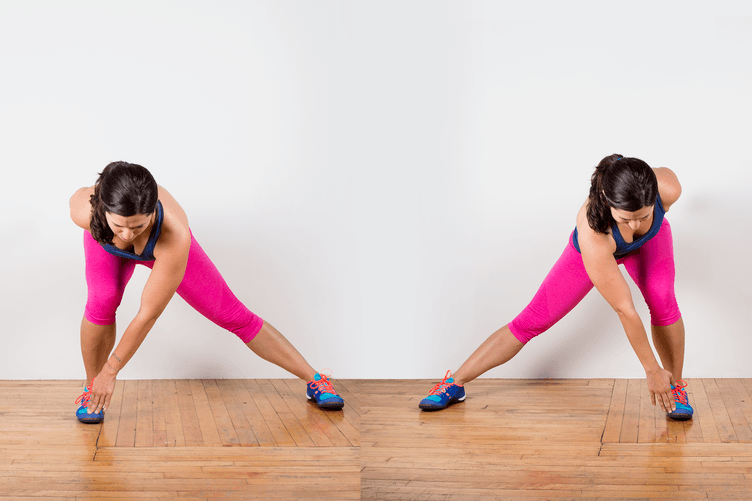
Stand with your feet spread wide, past your shoulders but only as far as you are comfortable.
Use your right hand and reach down to touch your left toes, and vice versa.
Repeat for ten repetitions on each side. If you have lower back pain, exercise caution or skip this stretch.
A Final Note on Stretches
These stretches can be used before a regular workout or to loosen up before a round of golf. You can use some of all of these in a session, but be sure to stretch the muscles you will be using in any workout or game.
While stretching is important and should be a constant part of your warm-up, we have to include a note of caution.
Blackburn cites an improper use of stretching as one of the major flaws of a self-directed training program. Many coaches assert that any tightness can be addressed through stretching. This is not necessarily true.
Tightness can come from a variety of causes and may be more severe. It can indicate a problem with your stability or the mobility of your joints.
You can even harm yourself with too much stretching. If you are unaware of an asymmetry, you could be overstretching muscles and worsen your imbalance. This risk is another reason an assessment is so important.
Posture Exercises
Don’t underestimate the importance of posture training. Many golfers sustain injuries due to an uncorrected posture.
It’s important for golfers to develop good posture as well as the stamina to hold it throughout a game.
Many exercises useful in developing posture and proper set up during a game have to do with the spine and pelvis.
Spine
The thoracic spine refers to areas of the upper and middle back. Often golfers flex these muscles too much. Ribs are connected to each part of the thoracic spine, limiting its flexibility. Workouts centered on these muscles train a golfer to carry themselves properly, as well as strengthen the muscles.
Some exercises related to thoracic spine strength, control and posture include the band pull-apart, utilizing a rubber resistance band, shoulder abduction exercises, and a bent over row.
Bent over row
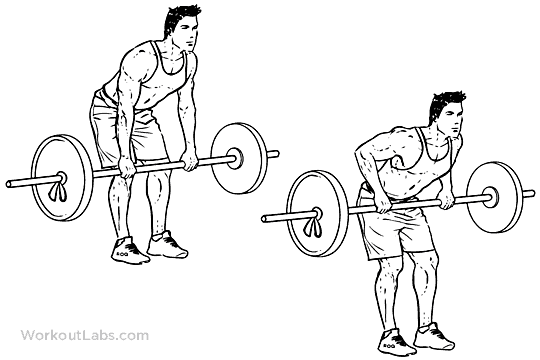
To do the bent over row, take a barbell and load the weights of your choice on it.
Keep your knees slightly bent and your back straight. Pull the barbell up to around your sternum, below your chest but above your stomach.
Pelvis
Pelvic exercises are also be geared toward strength, control, and positioning. These are typically anti-extension exercises, which train you to actively resist extending your lumbar spine, or lower back.
Exercises you can do for the pelvis include:
Dowel Hip Hinge
Take a dowel or even a golf club and hold it vertically behind your back. You should grasp the dowel in two places, with one hand at the top just behind your shoulders, the other hand behind your waist.
Keeping your back straight against the dowel, bend slowly at the waist, allowing your knees to bend slightly as well. Straighten up and repeat. Try to maintain three points of contact on your spine while doing this exercise.
Here’s a video example.
Variations include the kettlebell hip hinge and the hex bar hip hinge. When using a kettlebell, hold the weight in front of your close to the body around your stomach.
When using a hex bar, place the bar and its weights on the ground after each repetition. Remember to keep you back straight and allow your pelvis to extend backward.
Plank Hold with Varying Stability Points
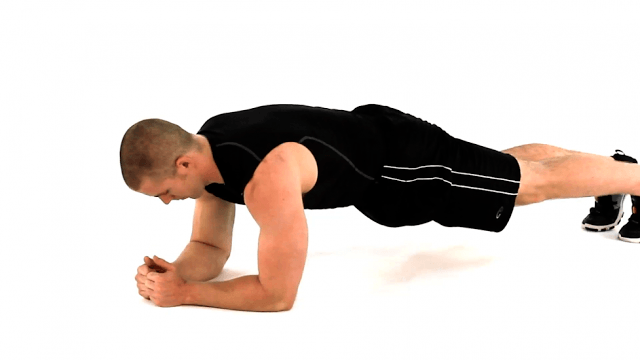
Begin in pushup position, then shift your arms to support your weight along your forearms. Maintain your weight at intervals of 30 seconds to one minute. Allow for proper rest, and then repeat.
In this position, you have four stability points. To give yourself a challenge, try the exercise with three or two stability points.
Contra-lateral Plank Supermans
This is a plank with two stability points one arm and the leg opposite to that arm. The “Superman” component involves lifting your free arm and leg, holding for a few seconds, and pulling it back in toward your body.
Repeat and stop if you find yourself losing the strength to keep your form.
Here’s an example video.
Walk-out
Walk out is another anti-extension exercise that is easy to do. Keeping your core tight, bend over until your hands are on the ground and then “walk out” into a plank position.
Your hands should be under your head. Then “walk” your hands backward until you are back in standing position.
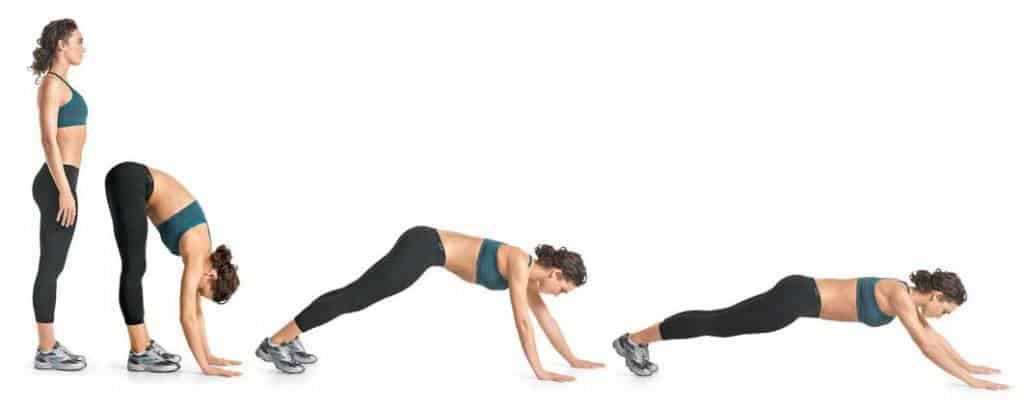
Rotation
As we said before, golf primarily uses not just one part of the body, but many. Wrists, elbows, shoulders, torso, hips, and knees are some of the primary muscles and joints we identified, but they are not the only ones used.
Golf also uses all three planes of motion. The three planes of motion are sagittal (from front to back), frontal (from side to side), and transverse (rotational movement). Most traditional training focuses on sagittal motion alone.
Since golf involves a high degree of rotation, some coaches focus entirely on transverse, but all three types of movement are used in a golf swing. Exercising in all three directional planes is vital.
The good news is, it’s not difficult to include all three types of movement. Many of the exercises above can be modified to incorporate other types.
Lunges are typically sagittal. Add a reach to your lunge, and you can alternate the direction of either your lunch or your reach. For example, you can do frontal lunges with transverse reaches or transverse lunges with sagittal reaches.
In golf, it’s important to be able to distinguish between torso rotation and pelvic rotation. Players should be able to rotate them separately, as individual components of the golf swing require more or less rotation in each part of the body. While this ability seems simple, it can be difficult for amateurs to master.
Pelvis Rotation
If you’ve taken a Pelvic Rotation screening test, you can begin from those results and practice the movements used in the test. In these exercises, it’s important to keep your upper body as stable as possible.
Begin with a progression, moving from a supported to an unsupported rotation. Since in this case, your upper body should remain still, start with an upper body supported pelvic rotation.
Here’s one more cool video showing a pelvic rotation drill:
Torso Rotation
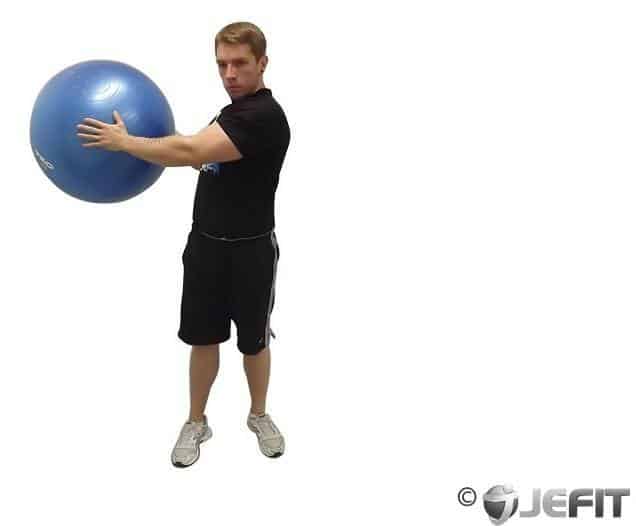
A strong golfer should also be able to rotate their torso independently. The pelvis and lower half of the body should have as little movement as possible.
When practicing independent torso rotation, the lower half of your body should feel like a solid base. It will also give you a feel for rotating around an axis.
Synchronized Pelvic and Torso Rotation

The final step in this routine is rotating the torso and pelvis together.
One good way to exercise this movement is through called a cable rotation variations. Using a machine’s pulley, grab the cable in one hand and rotate your whole body while you pull.
You can also practice an anti-rotation variety by keeping your torso and pelvis still and pulling the cable with only your arms. Cable rotations double as a way to develop muscle strength.
Applying the movement you’ve developed with the previous two stages should also result in this stage feeling different than before you expanded your range of movement.
Strength
What nearly every golfer looks for in a workout is strength training.
First, we want to refute one common method of strength training. Working out one body part a day used to be popular, but it has seen a decline in use for a reason.
This method is old-fashioned and more suited for bodybuilders. Instead, we encourage integrated exercises.
When you’re on a course, you’ll never use just one part of your body.
All your muscles and joints work together to produce the actions you need to do. In a sport-specific workout, you should always imitate the movements you’ll be making in a game, and that will never involve only legs or arms.
Strengths Needed in Golf
When golfers train for strength, they primarily need to train to increase their club head speed. In addition, they need to be able to apply force in three different directions: vertically, laterally, and rotationally.
Vertical Force
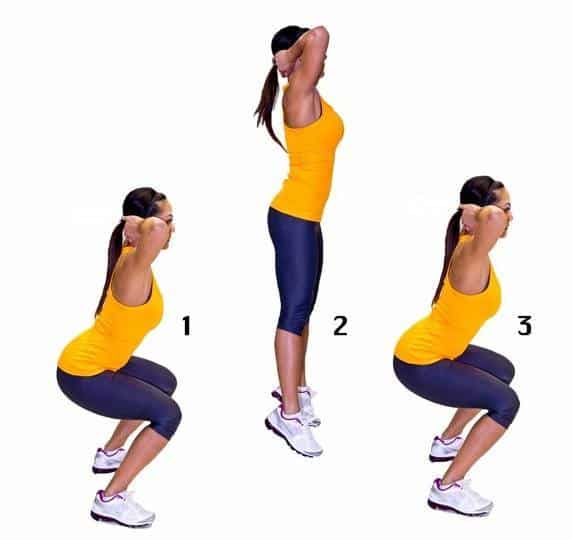
This is also called ground reaction force. The basic principle behind this is Newton’s third law of motion, stating that every action has an equal and opposite action.
Experienced golfers produce a lot of ground force, meaning they push strongly into the ground when hitting a strong shot. This force going into the ground allows them to exert more force when hitting outward.
Golfers can increase their vertical force through squat and jump variations.
Lateral Force
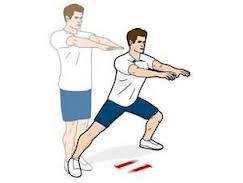
Lateral force refers to power that is transferred horizontally. For example, this is the reason for the backswing, which takes force in one direction to the other during impact.
To practice this skill, incorporate lateral lunges and lateral bound variations.
Lateral Bound Variations
To do a lateral bound, start on your right foot and jump laterally or sideways to your left. Jump back to your right and repeat the process.
Try to jump as high and far as you can, land gently, and don’t pause too long after each jump.
Rotational Force

We’ve already discussed rotations, but rotational force refers to the power a golfer can exert when rotating around their axis.
Effective exercises in this category are often throwing variations. They allow the player to practice a movement very similar to the golf swing.
Rotational Med Ball Wall Taps
Stand with a wall on one side, at least one foot away from you. Hold the ball comfortably in front of you. Rotate toward the wall and tap it with the ball. There are many natural progressions you can do with this exercise.
Try tossing the ball lightly at the wall and catching it, making sure you continue to rotate. To take it up another notch, stand further back and put in more force, making the exercise a throw rather than a tap.
You can also try standing on only one leg to add balance practice.
Cool Down
Don’t forget to cool down after your workout. Do a light physical activity like walking or jogging at a moderate pace on the treadmill.
Consistency is the key to an effective conditioning program, including regular rests between your rigorous workouts.
Vary the exercises in this article for a more interesting workout and look forward to noting your improvement.
Here’s also a cool infographic from pedalgoa.com
